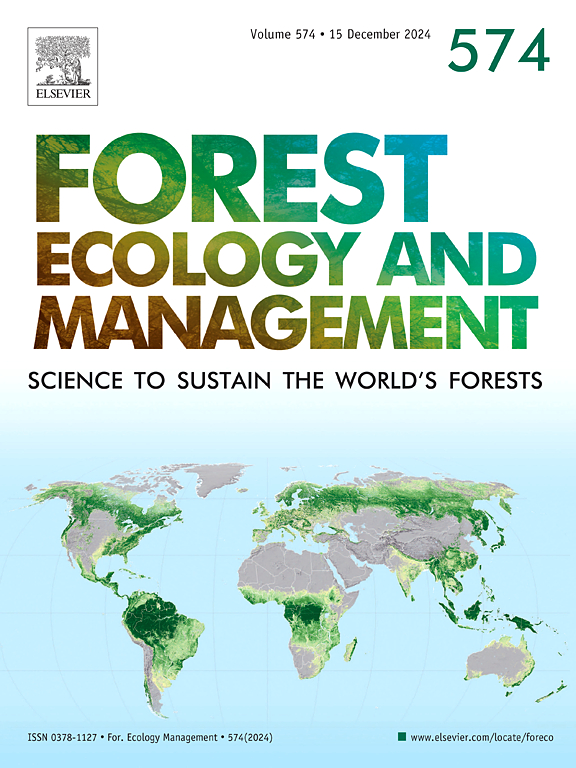研究开始22年后,栎树、山核桃和美洲栗树对重复规定的火和机械疏林的积极再生反应
IF 3.7
2区 农林科学
Q1 FORESTRY
引用次数: 0
摘要
自20世纪60年代以来,栎树(Quercus spp.)占主导地位的森林表现出较差的橡树更新和补充的趋势,其伴生的山核桃(Carya spp.)可能也经历了类似的趋势。此外,美洲板栗(Castanea dentata)对管理的反应研究很少。促进橡树再生的造林处理包括规定的火灾和林分间伐,但结果往往好坏参半。一个潜在的问题是在分析处理反应时将橡树和山核桃分类。这可能会模糊物种或属特异性反应,使造林处理的长期效果难以确定。因此,在种属水平上分析了栎树和山核桃幼苗和幼树对机械间伐、重复规定焚烧、间伐与焚烧联合以及非操纵对照的响应。处理地块还包括美洲板栗再生,包括在属特异性分析中。栎树对不同处理没有物种特异性反应,而山核桃幼树对不同处理有物种特异性反应,其光山核桃和绒毛山核桃的密度是野山核桃的2.5倍。当按属分组时,橡树和山核桃对个别处理有相似的反应,因此将它们的反应作为一个集体来分析是合适的。烧疏联合处理最有效,2022年橡树、山核桃和美洲板栗的平均树苗密度分别比2000年(预处理)提高了2362 %、1277 %和500 %。增加林下光照水平和降低中生植物竞争强度的长期森林管理似乎同样能够促进橡树、山核桃和潜在的美洲板栗的更新。本文章由计算机程序翻译,如有差异,请以英文原文为准。
Positive regeneration responses of oak, hickory, and american chestnut to repeated prescribed fires and mechanical thinning 22 years after study initiation
Since the 1960s, there has been an increasing trend in oak (Quercus spp.) dominated forests exhibiting poor oak regeneration and recruitment, and associated hickories (Carya spp.) are likely undergoing a similar trend. Additionally, American chestnut (Castanea dentata) responses to management have been poorly studied. Silvicultural treatments to increase oak regeneration include prescribed fires and stand thinning, but often show mixed results. One potential issue is grouping oaks and hickories when analyzing treatment responses. This may obscure species- or genus-specific responses, making the long-term efficacy of silvicultural treatments difficult to identify. Thus, oak and hickory seedling and sapling responses to mechanical thinning, repeated prescribed burning, combined thinning and burning, and unmanipulated controls were analyzed at the species and genus level. Treatment plots also included American chestnut regeneration, were included in the genus-specific analyses. There was no evidence of species-specific responses to individual treatments in oak, while species-specific responses were observed in sapling hickories with Carya glabra and Carya tomentosa densities being 2.5 times greater than Carya ovata. When grouped by genus, oak and hickory have similar responses to individual treatments, thus analyzing their responses as a collective group is appropriate. The combined burning and thinning treatment was most effective with average sapling densities increasing by 2362 %, 1277 %, and 500 % for oak, hickory, and American chestnut, respectively, as of 2022 compared to 2000 (pre-treatment). Long-term forest management to increase understory light levels and decrease the competitive strength of mesophytes appears equally capable of promoting oak, hickory, and potentially American chestnut regeneration.
求助全文
通过发布文献求助,成功后即可免费获取论文全文。
去求助
来源期刊

Forest Ecology and Management
农林科学-林学
CiteScore
7.50
自引率
10.80%
发文量
665
审稿时长
39 days
期刊介绍:
Forest Ecology and Management publishes scientific articles linking forest ecology with forest management, focusing on the application of biological, ecological and social knowledge to the management and conservation of plantations and natural forests. The scope of the journal includes all forest ecosystems of the world.
A peer-review process ensures the quality and international interest of the manuscripts accepted for publication. The journal encourages communication between scientists in disparate fields who share a common interest in ecology and forest management, bridging the gap between research workers and forest managers.
We encourage submission of papers that will have the strongest interest and value to the Journal''s international readership. Some key features of papers with strong interest include:
1. Clear connections between the ecology and management of forests;
2. Novel ideas or approaches to important challenges in forest ecology and management;
3. Studies that address a population of interest beyond the scale of single research sites, Three key points in the design of forest experiments, Forest Ecology and Management 255 (2008) 2022-2023);
4. Review Articles on timely, important topics. Authors are welcome to contact one of the editors to discuss the suitability of a potential review manuscript.
The Journal encourages proposals for special issues examining important areas of forest ecology and management. Potential guest editors should contact any of the Editors to begin discussions about topics, potential papers, and other details.
 求助内容:
求助内容: 应助结果提醒方式:
应助结果提醒方式:


